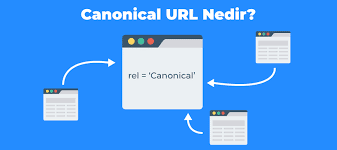[vc_row row_type=”row” use_row_as_full_screen_section=”no” type=”full_width” text_align=”left” css_animation=”” box_shadow_on_row=”no”][vc_column][vc_column_text]Canonical URLs help webmasters solve the problem of duplicate content.
Knowing how to implement them correctly is essential for SEO.
Also, using them incorrectly can adversely affect your site’s performance.
Canonical tags have been around since 2009. Google, Microsoft, and
Yahoo came together to create them to help site owners quickly resolve
duplicate content issues.
This article explains what canonical URLs are, how they work, why they are
crucial for your website, and how to use them.
Let’s go ![/vc_column_text][vc_column_text]The canonical URL, aka canonical tag, is an HTML link element with the rel=Canonicals attribute found in the elements of your web page. Canonical tags tell search engines the preferred URL among different versions of the web page. Search engines know which web page to crawl and index through canonical tags.
Although the URLs are different, they refer to the same web page.
Search engines can find this difficult because they don’t necessarily know
which one has the right content.
However, if you use a canonical URL, search engines will only rank the
preferred version of your URL from a set of URLs and ignore the rest.
So even if different site URLs have the same content, your site will not be
penalized by Google.[/vc_column_text][vc_column_text]
Why do I have duplicate content?
[/vc_column_text][/vc_column][/vc_row][vc_row row_type=”row” use_row_as_full_screen_section=”no” type=”full_width” text_align=”left” css_animation=”” box_shadow_on_row=”no”][vc_column][vc_column_text]If you own a website, you know that content is king. In addition to attracting
and engaging visitors to your site, this is what search engines analyze
when ranking websites.
If your content is unique, relevant, and engaging, it is more likely to rank
higher in search engines.
On the contrary, search engines will decrease your ranking if your site
contains duplicate content.
Some webmasters don’t even know they have duplicate content on their
websites.[/vc_column_text][vc_column_text]
what are the reasons for duplicate content?
[/vc_column_text][vc_column_text]Several reasons can lead to content duplication. These include:
Regional domain prefix: If your website is available in different regions, you
should use canonical tags to point to the main content to avoid duplicate
content.
Transfer protocol/subdomain variations: If you can access a site through
different URLs, as mentioned above, search engines will consider them as
separate pages.
Mobile versions: Mobile versions of the site are often available via different
URLs. You should use canonical tags to tell them apart.
Product pages: The problem of duplicate content is very common in
e-commerce stores, especially when there are different variations of the
same product.
Copied Content: In some cases, you may need more than one website to
post the same content. If so, you need to canonicalize the privileged
content.
Google Panda was an algorithm launched in 2011 that penalized sites with
lots of duplicates and low-quality content. Today, Panda is part of Google’s
main algorithm.
If you don’t want Panda to hit your site, you need to identify and fix
duplicate content issues on your site using canonical URLs.[/vc_column_text][vc_column_text]
Why are canonical tags/URLs important for SEO?
[/vc_column_text][vc_column_text]The primary function of canonical tags is to resolve duplicate content
issues.
However, canonical URLs are also crucial for SEO. Here’s why.
Canonical tags specify the URL you want to appear in search results.
When you define a canonical tag, search engines know which version of
the page to display. Duplicate content can cause several SEO issues, and
search engines may not know what content to rank for. Therefore, they are
missing out on some of your authoritative content.
Canonical tags make it easy to track metrics for a single product/topic.
When there are multiple URLs, it can be difficult to get consolidated metrics
for individual content. However, using canonical tags makes it easier to
track the performance of each page.
It prevents Googlebot from crawling duplicate pages.
If you have a large website, canonical tags allow Googlebot to crawl your
new web pages instead of duplicating versions of the same content.
However, this can only be a problem if you have hundreds or thousands of
pages.
Canonical URLs help consolidate links for duplicate content and manage
syndicated content.
Canonical URLs help search engines combine information about a URL
into a single authoritative URL. In addition, they also help consolidate page
rankings to your preferred URL.[/vc_column_text][vc_column_text]
When and how to use Canonical tags?
[/vc_column_text][vc_column_text]Now that you understand what canonical tags are and their importance for
SEO, let’s see when and how to use them.
Use canonical tags whenever you have duplicate content on your site.
Use them when you offer similar products with a slight difference,
especially if you own an e-commerce store.
Use them to structure additional information for a specific URL. It allows
you to sort and specify the content of a web page (URL parameters).
Need to improve your canonical URLs?
Let’s talk about your problem!
We will respond to you in less than 24 hours.[/vc_column_text][/vc_column][/vc_row]












